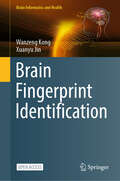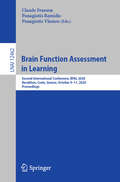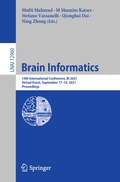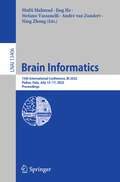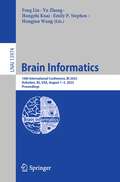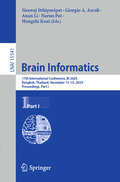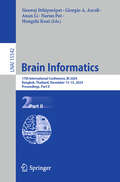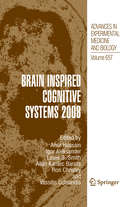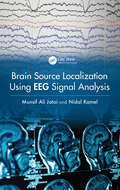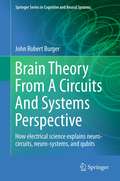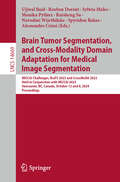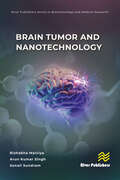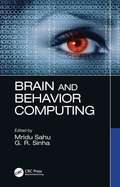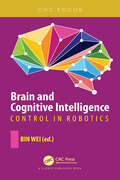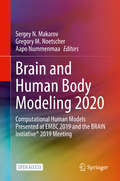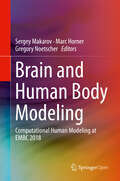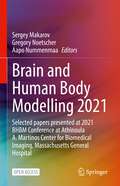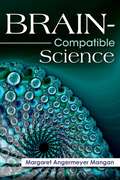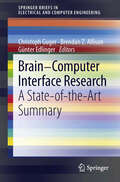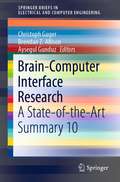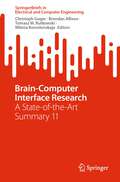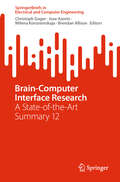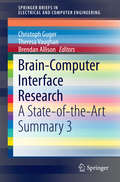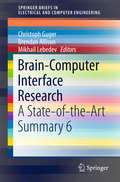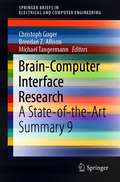- Table View
- List View
Brain Fingerprint Identification (Brain Informatics and Health)
by Wanzeng Kong Xuanyu JinThis open access book delves into the emerging field of biometric identification using brainwave patterns. Specifically, this book presents recent advances in electroencephalography (EEG)-based biometric recognition to identify unique neural signatures that can be used for secure authentication and identification. Traditional biometric systems such as fingerprints, iris scans, and face recognition have become integral to security and identification. However, these methods are increasingly vulnerable to spoofing and other forms of attack. Unlike other traditional biometrics, EEG signals are non-invasive, continuous authentication, liveness detection, and resistance to coercion due to the complexity and uniqueness of brain patterns. Therefore, it is particularly suitable for high-security fields such as military and finance, providing a promising alternative for future high-security identification and authentication. However, most of the existing brain fingerprint identification studies require subjects to perform specific cognitive tasks, which limits the popularization and application of brain fingerprint identification in practical scenarios. Additionally, due to the low signal-to-noise ratio (SNR) and time-varying characteristics of EEG signals, there are distribution differences in EEG data across sessions from several days, leading to stability issues in brain fingerprint features extracted at different sessions. Finally, because the EEG signal is affected by the coupling of multiple factors and the nervous system has continuous spontaneous variability, which makes it difficult for the brain fingerprint identification model to be suitable for the scenarios of unseen sessions and cognitive tasks, and there is the problem of insufficient model generalization. In this book, based on traditional machine learning methods and deep learning methods, the authors will carry out multi-task single-session, single-task multi-session, and multi-task multi-session brain fingerprint identification research respectively for the above problems, to provide an effective solution for the application of brain fingerprint identification in practical scenarios.
Brain Function Assessment in Learning: Second International Conference, BFAL 2020, Heraklion, Crete, Greece, October 9–11, 2020, Proceedings (Lecture Notes in Computer Science #12462)
by Claude Frasson Panagiotis Bamidis Panagiotis VlamosThis book constitutes the thoroughly refereed proceedings of the Second International Conference on Brain Function Assessment in Learning, BFAL 2020, held in Heraklion, Crete, Greece, in October 2020*.The 11 revised full papers and 10 short papers presented were carefully selected from 35 submissions. The BFAL conference aims to regroup research in multidisciplinary domains such as neuroscience, computer science, medicine, education, human-computer interactions, and social interaction on the theme of Brain Function Assessment in Learning.*The conference was held virtually due to the COVID-19 pandemic.
Brain Informatics: 14th International Conference, BI 2021, Virtual Event, September 17–19, 2021, Proceedings (Lecture Notes in Computer Science #12960)
by Ning Zhong Mufti Mahmud Stefano Vassanelli Qionghai Dai M Shamim KaiserThis book constitutes the refereed proceedings of the 14th International Conference on Brain Informatics, BI 2021, held in September 2021. The conference was held virtually due to the COVID-19 pandemic. The 49 full and 2 short papers together with 18 abstract papers were carefully reviewed and selected from 90 submissions. The papers are organized in the following topical sections: cognitive and computational foundations of brain science; investigations of human information processing systems; brain big data analytics, curation and management; informatics paradigms for brain and mental health research; and brain-machine intelligence and brain-inspired computing.
Brain Informatics: 15th International Conference, BI 2022, Padua, Italy, July 15–17, 2022, Proceedings (Lecture Notes in Computer Science #13406)
by Jing He Ning Zhong Mufti Mahmud Stefano Vassanelli André Van ZundertThis book constitutes the refereed proceedings of the 15th International Conference on Brain Informatics, BI 2022, held as hybrid event in Padua, Italy (in person) and Queensland, Australia (online) in July 2022. The 29 papers were selected from 65 submissions and the main theme of BI 2022 is Brain Science meets Artificial Intelligence with respect to the five tracks: Cognitive and computational foundations of brain science; human information processing systems; brain big data analytics, curation and management; informatics paradigms for brain and mental health research; and brain-machine intelligence and brain inspired computing.
Brain Informatics: 16th International Conference, BI 2023, Hoboken, NJ, USA, August 1–3, 2023, Proceedings (Lecture Notes in Computer Science #13974)
by Feng Liu Yu Zhang Hongjun Wang Hongzhi Kuai Emily P. StephenThis book constitutes the proceedings of the 16th International Conference on Brain Informatics, BI 2023, which was held in Hoboken, NJ, USA, during August 1–3, 2023.The 40 full papers presented in this book were carefully reviewed and selected from 101 submissions. The papers are divided into the following topical sections: cognitive and computational foundations of brain science; investigations of human Information processing systems; brain big data analytics, curation and management; informatics paradigms for brain and mental health research; brain-machine intelligence and brain-inspired computing; and the 5th international workshop on cognitive neuroscience of thinking and reasoning.
Brain Informatics: 17th International Conference, BI 2024, Bangkok, Thailand, December 13–15, 2024, Proceedings, Part I (Lecture Notes in Computer Science #15541)
by Giorgio A. Ascoli Hongzhi Kuai Sirawaj Itthipuripat Anan Li Narun PatThis book constitutes the proceedings of the 17th International Conference on Brain Informatics, BI 2024, which was held in Bangkok, Thailand, during December 13–15, 2024. The 35 full papers and 17 workshop papers presented in this book were carefully reviewed and selected from 126 submissions. These papers have been organized in the following topical sections: Pat I- Cognitive and Computational Foundations of Brain Science; Investigations of Human Information Processing Systems; Brain Big Data Analytics, Curation and Management; Informatics Paradigms for Brain and Mental Health Research; Brain-Machine Intelligence and Brain-Inspired Computing. Part II- The International Workshop on Generative AI Empowers Brain Signal Processing (GAIEBSP 2024); The International Workshop on Web Intelligence meets Brain Informatics (WImeetsBI 2024); The 4th Workshop on Environmental Adaptation and Mental Health (EAMH 2024); The International Workshop on Application of Artificial Intelligence and Innovative Technologies in Brain Informatics and Health (AAIITBIH 2024); The International Workshop on Reconstruction and Modeling of the Brain at the Single-Cell Level (RMBSCL 2024); The International Workshop on Mesoscopic Brain-wide Connectivity Atlas in Brainsmatics (MBCAB 2024); The 4th Special Session on Explainable Artificial Intelligence for Unveiling the Brain: From the Black-Box to the Glass-Box (XAIB 2024); The International Workshop on Elucidation of Mechanistic Information using Neuroimaging for Psychiatric Disorders (EMINPD 2024).
Brain Informatics: 17th International Conference, BI 2024, Bangkok, Thailand, December 13–15, 2024, Proceedings, Part II (Lecture Notes in Computer Science #15542)
by Giorgio A. Ascoli Hongzhi Kuai Sirawaj Itthipuripat Anan Li Narun PatThis book constitutes the proceedings of the 17th International Conference on Brain Informatics, BI 2024, which was held in Bangkok, Thailand, during December 13–15, 2024. The 35 full papers 17 workshop papers presented in this book were carefully reviewed and selected from 126 submissions. These papers have been organized in the following topical sections: Pat I- Cognitive and Computational Foundations of Brain Science; Investigations of Human Information Processing Systems; Brain Big Data Analytics, Curation and Management; Informatics Paradigms for Brain and Mental Health Research; Brain-Machine Intelligence and Brain-Inspired Computing. Part II- The International Workshop on Generative AI Empowers Brain Signal Processing (GAIEBSP 2024); The International Workshop on Web Intelligence meets Brain Informatics (WImeetsBI 2024); The 4th Workshop on Environmental Adaptation and Mental Health (EAMH 2024); The International Workshop on Application of Artificial Intelligence and Innovative Technologies in Brain Informatics and Health (AAIITBIH 2024); The International Workshop on Reconstruction and Modeling of the Brain at the Single-Cell Level (RMBSCL 2024); The International Workshop on Mesoscopic Brain-wide Connectivity Atlas in Brainsmatics (MBCAB 2024); The 4th Special Session on Explainable Artificial Intelligence for Unveiling the Brain: From the Black-Box to the Glass-Box (XAIB 2024); The International Workshop on Elucidation of Mechanistic Information using Neuroimaging for Psychiatric Disorders (EMINPD 2024).
Brain Inspired Cognitive Systems 2008 (Advances in Experimental Medicine and Biology #657)
by Leslie S. Smith Ron Chrisley Igor Aleksander Amir Hussain Allan Kardec Barros Vassilis CutsuridisBrain Inspired Cognitive Systems 2008 (June 24-27, 2008; São Luís, Brazil) brought together leading scientists and engineers who use analytic, syntactic and computational methods both to understand the prodigious processing properties of biological systems and, specifically, of the brain, and to exploit such knowledge to advance computational methods towards ever higher levels of cognitive competence. This book includes the papers presented at four major symposia: Part I - Cognitive Neuroscience Part II - Biologically Inspired Systems Part III - Neural Computation Part IV - Models of Consciousness.
Brain Source Localization Using EEG Signal Analysis
by Munsif Ali Jatoi Nidal KamelOf the research areas devoted to biomedical sciences, the study of the brain remains a field that continually attracts interest due to the vast range of people afflicted with debilitating brain disorders and those interested in ameliorating its effects. To discover the roots of maladies and grasp the dynamics of brain functions, researchers and practitioners often turn to a process known as brain source localization, which assists in determining the source of electromagnetic signals from the brain. Aiming to promote both treatments and understanding of brain ailments, ranging from epilepsy and depression to schizophrenia and Parkinson’s disease, the authors of this book provide a comprehensive account of current developments in the use of neuroimaging techniques for brain analysis. Their book addresses a wide array of topics, including EEG forward and inverse problems, the application of classical MNE, LORETA, Bayesian based MSP, and its modified version, M-MSP. Within the ten chapters that comprise this book, clinicians, researchers, and field experts concerned with the state of brain source localization will find a store of information that can assist them in the quest to enhance the quality of life for people living with brain disorders.
Brain Theory From A Circuits And Systems Perspective: How Electrical Science Explains Neuro-circuits, Neuro-systems, and Qubits (Springer Series in Cognitive and Neural Systems #6)
by John Robert BurgerThis book models an idealized neuron as being driven by basic electrical elements, the goal being to systematically characterize the logical properties of neural pulses. In order to constitute a system, neurons as pulsating devices may be represented using novel circuit elements as delineated in this book. A plausible brain system is implied by the delineated elements and logically follows from known and likely properties of a neuron. New to electrical science are novel pulse-related circuit elements involving recursive neurons. A recursive neuron, when properly excited, produces a self-sustaining pulse train that when sampled, provides a true output with a specified probability, and a false output with complementary probability. Because of its similarity to the qubits of quantum mechanics, the recursive pulsating neuron is termed a simulated qubit. Recursive neurons easily function as controlled toggle devices and so are capable of massively parallel calculations, this being a new dimension in brain functioning as described in this book. Simulated qubits and their possibilities are compared to the qubits of quantum physics. Included in the book are suggested neural circuits for associative memory search via a randomized process of cue selection, and neural circuits for priority calculations. These serve to select returns from long term memory, which in turn determines one's next conscious thought or action based on past memorized experiences. The book reports on proposals involving electron tunneling between synapses, and quantum computations within neurons. Although not a textbook, there are easy exercises at the ends of chapters, and in the appendix there are twelve simulation experiments concerning neurons.
Brain Tumor Segmentation, and Cross-Modality Domain Adaptation for Medical Image Segmentation: MICCAI Challenges, BraTS 2023 and CrossMoDA 2023, Held in Conjunction with MICCAI 2023, Vancouver, BC, Canada, October 12 and 8, 2024, Proceedings (Lecture Notes in Computer Science #14669)
by Alessandro Crimi Spyridon Bakas Ujjwal Baid Sylwia Malec Monika Pytlarz Reuben Dorent Ruisheng Su Navodini WijethilakeThis book constitutes the refereed proceedings of the Brain Tumor Segmentation Challenge, BraTS 2023, as well as the Cross-Modality Domain Adaptation Challenge, CrossMoDA 2023. These events were held in conjunction with the Medical Image Computing for Computer Assisted Intervention Conference, MICCAI 2023, during October 8-12, 2023. The 37 full papers presented in this volume were selected form 23 submissions. They describe the research of computational scientists and clinical researchers working on brain lesions, and specifically glioma, multiple sclerosis, cerebral stroke, traumatic brain injuries, vestibular schwannoma, and white matter hyper-intensities of presumed vascular origin.
Brain Tumor and Nanotechnology (River Publishers Series in Biotechnology and Medical Research)
by Arun Kumar Singh Rishabha Malviya Sonali SundramBrain Tumors and Nanotechnology explores the complex world of brain tumors and the ground-breaking role that nanotechnology is playing in both detection and treatment. It offers comprehensive and up-to-date strategies in the treatment of brain tumors, with a special emphasis on the revolutionary impact of nanotechnology. It begins with an in-depth analysis of the anatomy of the brain and nervous system, highlighting the constituents of the central nervous system (CNS) such as neurons and glial cells. It also offers a thorough understanding of the intricate structure of the human brain, including the hemispheres, brainstem, diencephalon, and ventricular system. It then reveals the understanding of the complicated nature of brain tumors and the potential for nanotechnology to revolutionize their diagnosis and treatment. Brain Tumors and Nanotechnology will be a longstanding valuable resource for researchers, medical professionals, and students in the field.
Brain and Behavior Computing
by Mridu SahuBrain and Behavior Computing offers insights into the functions of the human brain. This book provides an emphasis on brain and behavior computing with different modalities available such as signal processing, image processing, data sciences, statistics further it includes fundamental, mathematical model, algorithms, case studies, and future research scopes. It further illustrates brain signal sources and how the brain signal can process, manipulate, and transform in different domains allowing researchers and professionals to extract information about the physiological condition of the brain. Emphasizes real challenges in brain signal processing for a variety of applications for analysis, classification, and clustering. Discusses data sciences and its applications in brain computing visualization. Covers all the most recent tools for analysing the brain and it’s working. Describes brain modeling and all possible machine learning methods and their uses. Augments the use of data mining and machine learning to brain computer interface (BCI) devices. Includes case studies and actual simulation examples. This book is aimed at researchers, professionals, and graduate students in image processing and computer vision, biomedical engineering, signal processing, and brain and behavior computing.
Brain and Cognitive Intelligence: Control in Robotics
by Bin WeiThe aim of the book is to introduce the state-of-the-art technologies in the field of brain and cognitive intelligence used in robotics control, particularly on studying how the brain learns and controls complex motor skills and how to replicate these in robots. This will be the first book that systematically and thoroughly deals with the above topics. Advances made in the past decades are described. Interesting topics such as human-robot interactions, neurorobotics, biomechanics in robotic control, robot vision, force control, and control and coordination of humanoid robots are covered.
Brain and Human Body Modeling 2020: Computational Human Models Presented at EMBC 2019 and the BRAIN Initiative® 2019 Meeting
by Gregory M. Noetscher Sergey N. Makarov Aapo NummenmaaThis open access book describes modern applications of computational human modeling in an effort to advance neurology, cancer treatment, and radio-frequency studies including regulatory, safety, and wireless communication fields. Readers working on any application that may expose human subjects to electromagnetic radiation will benefit from this book’s coverage of the latest models and techniques available to assess a given technology’s safety and efficacy in a timely and efficient manner.Describes computational human body phantom construction and application;Explains new practices in computational human body modeling for electromagnetic safety and exposure evaluations;Includes a survey of modern applications for which computational human phantoms are critical.
Brain and Human Body Modeling: Computational Human Modeling at EMBC 2018
by Sergey Makarov Marc Horner Gregory NoetscherThis open access book describes modern applications of computational human modeling with specific emphasis in the areas of neurology and neuroelectromagnetics, depression and cancer treatments, radio-frequency studies and wireless communications. Special consideration is also given to the use of human modeling to the computational assessment of relevant regulatory and safety requirements. Readers working on applications that may expose human subjects to electromagnetic radiation will benefit from this book’s coverage of the latest developments in computational modelling and human phantom development to assess a given technology’s safety and efficacy in a timely manner.Describes construction and application of computational human models including anatomically detailed and subject specific models;Explains new practices in computational human modeling for neuroelectromagnetics, electromagnetic safety, and exposure evaluations;Includes a survey of modern applications for which computational human models are critical;Describes cellular-level interactions between the human body and electromagnetic fields.
Brain and Human Body Modelling 2021: Selected papers presented at 2021 BHBM Conference at Athinoula A. Martinos Center for Biomedical Imaging, Massachusetts General Hospital
by Sergey Makarov Gregory Noetscher Aapo NummenmaaThis open access book describes modern applications of computational human modelling to advance neurology, cancer treatment, and radio-frequency studies including regulatory, safety, and wireless communication fields. Readers working on any application that may expose human subjects to electromagnetic radiation will benefit from this book’s coverage of the latest models and techniques available to assess a given technology’s safety and efficacy in a timely and efficient manner.This is an Open Access book.
Brain-Compatible Science
by Margaret Angermeyer ManganGain fresh insights for teaching, learning, and assessing knowledge of critical science concepts through the exploration of research-based practices for science education.
Brain-Computer Interface Research: A State-of-the-Art Summary (SpringerBriefs in Electrical and Computer Engineering #6)
by Brendan Z. Allison Christoph Guger Günter EdlingerBrain-computer interfaces (BCIs) are rapidly developing into a mainstream, worldwide research endeavor. With so many new groups and projects, it can be difficult to identify the best ones. This book summarizes ten leading projects from around the world. About 60 submissions were received in 2011 for the highly competitive BCI Research Award, and an international jury selected the top ten. This Brief gives a concise but carefully illustrated and fully up-to-date description of each of these projects, together with an introduction and concluding chapter by the editors.
Brain-Computer Interface Research: A State-of-the-Art Summary 10 (SpringerBriefs in Electrical and Computer Engineering)
by Brendan Z. Allison Christoph Guger Aysegul GunduzThe Annual BCI Research Awards are international prizes that recognize the top new projects in brain–computer interface (BCI) research. This book contains concise descriptions of projects nominated for the 2020 BCI Research Award and interviews with nominees. Each article is authored by the researchers who developed the project, and articles have been updated with new progress achieved since their nomination. These chapters are complemented by an introduction by the editors together with a concluding chapter that reviews the annual Awards Ceremony, announces the winners, and ends with a brief discussion.One of the prominent trends in recent years has been the development of BCIs for restoring limb use and for aiding optical and auditory sensory perception. Many chapters in this book present emerging and novel research directions likely to become more prevalent in the near future. This year's book includes chapters based on interviews with BCI experts who were nominated for an award, including this year's first, second, and third place winners. These interview chapters are generally less technical than project descriptions, and provide individual perspectives from people actively working on new methods and systems.
Brain-Computer Interface Research: A State-of-the-Art Summary 11 (SpringerBriefs in Electrical and Computer Engineering)
by Brendan Allison Christoph Guger Tomasz M. Rutkowski Milena KorostenskajaThis book showcases recent trends in brain-computer interface development. It highlights fascinating results in areas such as language decoding, spinal cord stimulation to enable gait and to restore hand functions. The contributions are based on the 12 nominated brain-computer interface projects of the BCI Award 2022. Every year an international jury selects the most innovate BCI projects and nominates 12 projects before selecting the 1st, 2nd and 3rd place winners. In the book, each project is described in detail by the team of scientists behind it, and the editors provide a concluding discussion of the highlights and overall progress in the field.
Brain-Computer Interface Research: A State-of-the-Art Summary 12 (SpringerBriefs in Electrical and Computer Engineering)
by Brendan Allison Christoph Guger Milena Korostenskaja Jose AzorinThis book showcases recent trends in brain-computer interface development. It highlights fascinating results in areas such as speech neuroprotheses, bionic hands, memory enhancement, and the development of optical BCIs . The contributions describe the three winning projects and other nominated brain-computer interface projects selected by the expert international jury of the BCI Award 2023. In the book, each project is described in detail by the team of scientists behind it, and the editors provide a concluding discussion of the highlights and overall progress in the field.
Brain-Computer Interface Research: A State-of-the-Art Summary 3 (SpringerBriefs in Electrical and Computer Engineering #6)
by Brendan Allison Christoph Guger Theresa VaughanThis book provides a cutting-edge overview of the latest developments in Brain-Computer-Interfaces (BCIs), reported by leading research groups. As the reader will discover, BCI research is moving ahead rapidly, with many new ideas, research initiatives, and improved technologies, e. g. BCIs that enable people to communicate just by thinking - without any movement at all. Several different groups are helping severely disabled users communicate using BCIs, and BCI technology is also being extended to facilitate recovery from stroke, epilepsy, and other conditions. Each year, hundreds of the top BCI scientists, engineers, doctors, and other visionaries compete for the most prestigious honor in the BCI research community: the annual BCI Award. The 2013 BCI Award competition was by far the most competitive, with over 160 research groups vying for a nomination. The chapters of this book summarize the ten projects that were nominated, in particular the winning project, and analyses how these reflect general trends in BCI development. Each project summary includes an introduction, description of methods, results, and also includes newer work completed after the project was entered for the competition. The texts are presented in accessible style with numerous supporting pictures, graphs, and figures.
Brain-Computer Interface Research: A State-of-the-Art Summary 6 (SpringerBriefs in Electrical and Computer Engineering #6)
by Brendan Allison Christoph Guger Mikhail LebedevBrain-computer interfaces (BCIs) are rapidly developing into a mainstream, worldwide research endeavor. With so many new groups and projects, it can be difficult to identify the best ones. This book summarizes ten leading projects from around the world. About 60 submissions were received in 2011 for the highly competitive BCI Research Award, and an international jury selected the top ten. This Brief gives a concise but carefully illustrated and fully up-to-date description of each of these projects, together with an introduction and concluding chapter by the editors.
Brain-Computer Interface Research: A State-of-the-Art Summary 9 (SpringerBriefs in Electrical and Computer Engineering)
by Brendan Z. Allison Christoph Guger Michael TangermannThe Annual BCI Research Awards are international prizes that recognize the top new projects in brain–computer interface (BCI) research. This book contains concise descriptions of projects nominated for the 2019 BCI Research Award and interviews with nominees. Each article is authored by the researchers who developed the project, and articles have been updated with new progress achieved since their nomination. These chapters are complemented by an introduction by the editors together with a concluding chapter that reviews the annual Awards Ceremony, announces the winners, and ends with a brief discussion.One of the prominent trends in recent years has been the development of BCIs for new patient groups. Many chapters in this book present emerging and novel research directions likely to become more prevalent in the near future. This year's book includes chapters based on interviews with BCI experts who were nominated for an award, including this year's first, second, and third place winners. These interview chapters are generally less technical than project descriptions, and provide individual perspectives from people actively working on new methods and systems.
